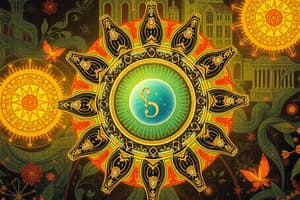Podcast
Questions and Answers
What does the atomic number of an element represent?
What does the atomic number of an element represent?
- The number of protons in the nucleus of an atom (correct)
- The average mass of all isotopes of an element
- The total mass of the atom in atomic mass units
- The total number of protons and neutrons in the nucleus
How is the mass number of an atom calculated?
How is the mass number of an atom calculated?
- By averaging the masses of all isotopes of the element
- By adding the number of protons to the number of neutrons (correct)
- By multiplying the atomic number by the relative atomic mass
- By adding the number of neutrons to the number of electrons
What are isotopes?
What are isotopes?
- Atoms that decay at the same rate regardless of their structure
- Atoms that have the same mass number but different atomic numbers
- Atoms that have identical chemical properties and different electron configurations
- Atoms that have different numbers of neutrons but the same number of protons (correct)
What is radioactivity?
What is radioactivity?
What does relative atomic mass refer to in relation to the carbon-12 scale?
What does relative atomic mass refer to in relation to the carbon-12 scale?
Which statement accurately describes isotopes?
Which statement accurately describes isotopes?
In the context of radioactivity, which term refers to the rate at which a radioactive substance decays?
In the context of radioactivity, which term refers to the rate at which a radioactive substance decays?
What is the correct relationship between atomic number and isotopes for an element?
What is the correct relationship between atomic number and isotopes for an element?
Which of the following correctly describes relative atomic mass as defined against the carbon-12 scale?
Which of the following correctly describes relative atomic mass as defined against the carbon-12 scale?
Which statement best explains the concept of mass number?
Which statement best explains the concept of mass number?
Flashcards are hidden until you start studying
Study Notes
Structure of the Atom
- Atoms consist of a nucleus surrounded by electrons.
- Nucleus contains protons (positive charge) and neutrons (no charge).
- Electrons orbit the nucleus in energy levels or shells.
Key Terminology
- Mass Number: Total number of protons and neutrons in an atom's nucleus; indicates the atomic mass.
- Atomic Number: Number of protons in an atom; determines the element's identity.
- Isotopes: Variants of a particular chemical element that have the same atomic number but different mass numbers due to differing numbers of neutrons.
Relative Atomic and Isotope Mass
- Relative Atomic Mass: Weighted average mass of an atom compared to 1/12 of the mass of carbon-12 (C-12).
- Relative Isotope Mass: Mass of an isotope relative to the mass of C-12; reflects differences in isotopes due to neutron count.
Radioactivity
- Radioactivity is the spontaneous emission of particles or radiation from an unstable atomic nucleus.
- Occurs when an atom has an excess of energy or mass, leading to decay into a more stable form.
- Three common types of radioactive decay: alpha decay (release of helium nuclei), beta decay (conversion of neutrons to protons), and gamma radiation (high-energy photons).
- Radioactive isotopes can be used in medicine, archaeology, and energy production.
Structure of the Atom
- Atoms consist of a nucleus surrounded by electrons.
- Nucleus contains protons (positive charge) and neutrons (no charge).
- Electrons orbit the nucleus in energy levels or shells.
Key Terminology
- Mass Number: Total number of protons and neutrons in an atom's nucleus; indicates the atomic mass.
- Atomic Number: Number of protons in an atom; determines the element's identity.
- Isotopes: Variants of a particular chemical element that have the same atomic number but different mass numbers due to differing numbers of neutrons.
Relative Atomic and Isotope Mass
- Relative Atomic Mass: Weighted average mass of an atom compared to 1/12 of the mass of carbon-12 (C-12).
- Relative Isotope Mass: Mass of an isotope relative to the mass of C-12; reflects differences in isotopes due to neutron count.
Radioactivity
- Radioactivity is the spontaneous emission of particles or radiation from an unstable atomic nucleus.
- Occurs when an atom has an excess of energy or mass, leading to decay into a more stable form.
- Three common types of radioactive decay: alpha decay (release of helium nuclei), beta decay (conversion of neutrons to protons), and gamma radiation (high-energy photons).
- Radioactive isotopes can be used in medicine, archaeology, and energy production.
Studying That Suits You
Use AI to generate personalized quizzes and flashcards to suit your learning preferences.




